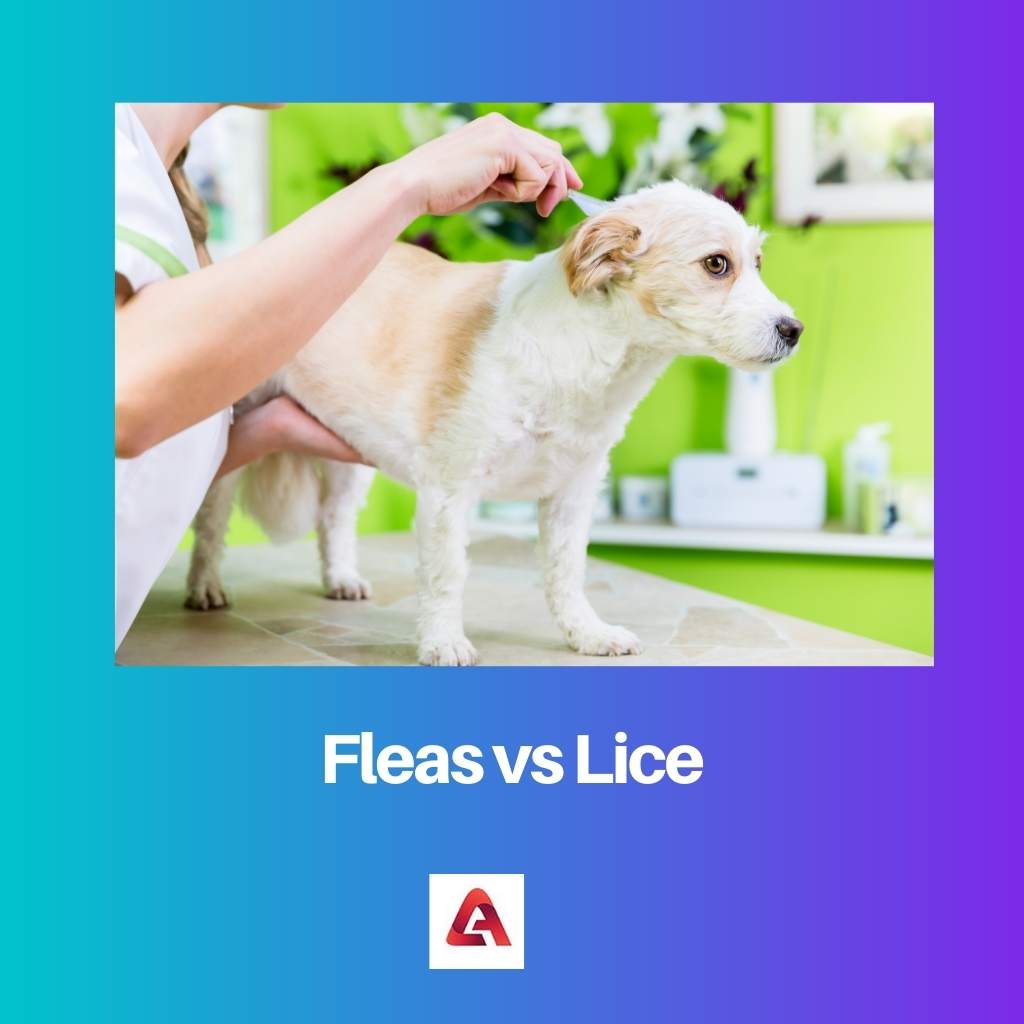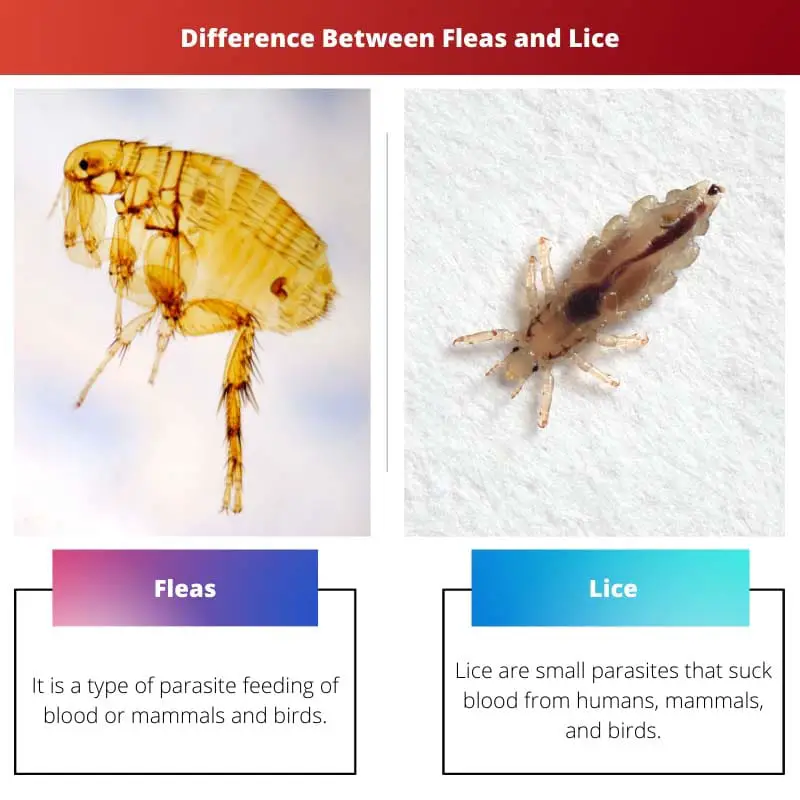There are different types of parasites. A parasite is those animals or insects which live inside another organism (host) and gets their food from them. These are classified as protozoa, helminths, and ectoparasites.
Ectoparasites are the type of parasite that lives on the outer surface of the host. The very common example of this class could be lice and fleas. Both of them are the type of Ectoparasite that lives on the external surface of humans, animals, and birds, respectively.
Key Takeaways
- Fleas are wingless insects that feed on the blood of humans and animals, while lice are tiny, wingless parasites that live on the skin and hair of mammals.
- Fleas can jump up to 7 inches, while lice cannot jump or fly.
- Fleas can transmit diseases like bubonic plague, while lice can spread typhus and trench fever.
Fleas vs Lice
The difference between fleas and lice is their host and their habitat. Lice are found mainly on the human on their hairy parts, mostly hairs or underarms, whereas Fleas are found mainly on the skin of birds and animals in the warm parts of the body. Another difference could be the ability of fleas to jump and the pain they cause. Lice cause less pain in comparison to fleas, which cause slightly more pain.

Fleas are the type of ectoparasites that are commonly founded in animals and birds it does not have wings and can cause various diseases, such as plague and myxomatosis, etc., with their bite, which also causes more pain.
It is not found in humans. It can bite them (feet or legs) but not live on them.
Lice are also a type of Ectoparasites found on hairy parts of the human body. It can also be found in mammals and birds but mainly lives of humans. It is spread by direct contact or in an unhygienic environment.
It does not cause much pain but irritation and itching. The presence of these can be felt on the skin.
Comparison Table
| Parameters of Comparison | Fleas | Lice |
|---|---|---|
| Types | Rat fleas, human fleas, cat fleas, and sand fleas | Head lice, body lice, and pubic lice |
| Habitat | live in warm parts of the body | mainly live on hairy parts of the body |
| Order | belong to the order Siphonaptera | belong to the order Phthiraptera |
| Size | fleas can grow up to 1-4 mm | the lice can grow up to 4.5 mm |
| Mode of Nutrition | blood parasites | symbiotic scavengers |
What is Fleas?
It is a type of parasite feeding on the blood of mammals and birds. This could be rarely found in humans.
Feature/appearance;
- Wingless.
- Light brown or reddish in color.
- Small and disproportional head.
- Large hind six legs
The main types of Fleas are:
- Cat fleas: found in cats, also known as Ctenocephalides felis.
- Dog Fleas: found in dogs, also known as Ctenocephalides canis.
- Human Fleas: found in the human body, mainly on feet or legs, also known as Pulex irritans.
Symptoms
- Intense itching.
- Swollen or red body part.
- A lump is seen on the infected area of the body.
- Minor infections
Fleas can sometimes lead to serious infections, such as rat fleas can cause bubonic plague and flea-borne typhus, and cat fleas can be responsible for the transmission of tapeworms. The one thing that mainly differentiates of from other ectoparasites is its ability to move fast and jump long.
Treatment
For treatment of the fleas, first of all, you have to make sure what is the source or carrier of these fleas. Suppose the pet has fleas which can be detected by noticing if they are scratching and itching on a particular area more frequently or if there is any red spot or swelling.
And after detecting it, they should be cleaned with anti-flea shampoo. And in some serious cases, a doctor should be considered.

What is Lice?
Lice are small parasites that suck blood from humans, mammals, and birds.
Three types of lice found among human beings are:
- Head Lice: also called Pediculus Humanus Capitis. These types are found in the head and can be seen roaming around the neck or the ear.
- Body Lice: also called Pediculus Humanus. These types are found in the body or clothes of a person, main dues to unhygienic.
- Pubic Lice: also called Pthirus pubis or crab. These are found in the pubic area, such as eyebrows or chest hair.
Symptoms:
- If there is itching in some areas.
- If there is a sensation of tickling in the body.
- If lice eggs or lice are visible in cloth or body.
- If bite marks are found on the body parts.
Causes:
- Direct physical contact from the head.
- Unhygienic clothes or clothes are stored tightly in a particular area for longer.
- Transmitted from friends or family.
- If an infected bed or furniture is used.
Prevention:
- Proper cleaning of clothes and hygiene should be maintained.
- Any direct head-to-head contact should be avoided, especially with a stranger.
- Proper distance should be maintained from the infected person.

Main Differences Between Fleas and Lice
- The shape of their body is also different from each other, lice are oval, and fleas are flat.
- Other than the size and shape, they also differ in the color of their body. Lice are dark grey, and fleas are reddish.
- The colors of the eggs lay by them are also different in colors. Fleas lay eggs of white color, and lice lay eggs of coffee color.
- The mode of nutrition for lice is symbiotic scavengers, and the mode of nutrition for all fleas is blood.
- Fleas can move quickly, but this ability lacks in the lice.
- Fleas also can jump because of their long hind legs, but lice cannot jump from one place to another.
- There are three life stages of the lice, but there are four life stages of the fleas.
- The lice have more host specificity than the fleas.

- https://pediatrics.aappublications.org/content/110/3/638.short
- https://www.sciencedirect.com/science/article/pii/B9780128140437000108

The comprehensive comparison and detailed analysis of fleas and lice make this article a valuable resource. The intellectual depth and clarity of content are commendable.
The intellectual rigor and clarity of explanations set this article apart as a valuable source of knowledge.
Agreed. The in-depth information and well-structured content make for an engaging read.
The detailed analysis and comparison of fleas and lice in this article make it a significant addition to the understanding of these parasites.
The clarity and depth of information are truly commendable.
This article is a testament to the importance of well-researched and comprehensive content.
The intellectual rigor and comprehensive analysis of fleas and lice in this article are commendable. It offers an insightful and valuable understanding of these parasites.
Agreed. The well-researched content provides an intellectually stimulating perspective on fleas and lice.
This is a well-structured, insightful article giving detailed knowledge about fleas and lice in a way that is easy to understand. It is indeed a valuable read.
Agreed. The clear and concise comparison makes it an interesting read.
Absolutely, the explanations are very clear and enlightening.
This article presents a wealth of knowledge about fleas and lice, delivered in a well-organized manner. The comprehensive information indeed adds value to the readers’ understanding.
The intellectual depth and informative details are evident in this article.
This article provides a comprehensive analysis of the differences between fleas and lice, ranging from their habitats to symptoms and treatment. The information provided here is enlightening and valuable.
I couldn’t agree more. The depth of research in this article is impressive.
Yes, this article is written in a very organized and informative manner.
The article is well-researched and informative, providing in-depth knowledge about the subject. The details about habitat, symptoms and treatment are particularly useful.
It’s refreshing to read an article with such well-presented and intellectual content.
Indeed, the detailed comparison and comprehensive information are commendable.
The insights and comprehensive analysis of fleas and lice presented in this article are truly enlightening. The comparison table provides a clear understanding of their differences and characteristics.
Absolutely, the amount of relevant information is impressive and intellectually stimulating.
The well-structured comparison and detailed symptoms provide a thorough understanding of these parasites.
This article offers a well-rounded understanding of the differences between fleas and lice. The informative details and intellectual content make it a must-read.
The intellectual depth and research evident in this article are commendable.
The detailed insights into the world of fleas and lice are truly enlightening. The comprehensive analysis provided in this article is commendable.
This article is a refreshing and intellectual perspective on the differences between fleas and lice.